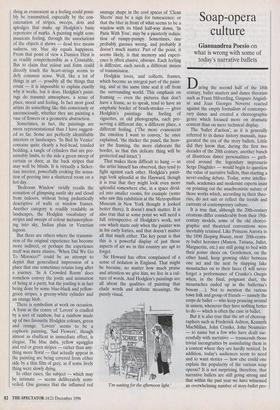Soap-opera culture
Giannandrea Poesio on what is wrong with some of today's narrative ballets During the second half of the 18th century, ballet masters and dance theorists such as Franz Hilverding, Gasparo Angioli- ni and Jean Georges Noverre reacted against the empty formalism of contempo- rary dance and created a choreographic genre which focused more on dramatic content than on mere technical display.
The 'ballet d'action', as it is generally referred to in dance history manuals, inau- gurated the era of the story ballets. Little did they know that, during the first two decades of the 20th century, another bunch of illustrious dance personalities — gath- ered around the legendary impresario Serge Diaghilev — would begin to question the value of narrative ballets, thus starting a never-ending debate. Today, some intellec- tuals, academics and modernist experts insist on pointing out the anachronistic nature of those works which, according tg_their theo- ries, do not suit or reflect the trends and currents of contemporary culture.
It is true that, although the 20th-century creations differ considerably from their 19th- century models, some of the old choreo- graphic and theatrical conventions were inevitably retained. Like Princess Aurora in the 1890 Sleeping Beauty, most 20th-centu- ry ballet heroines (Manon, Tatiana, Juliet, Marguerite, etc.) are still going to bed with their pointe shoes on. Gentlemen, on the other hand, keep growing older between one act and the next by slapping fake moustaches on to their faces (I will never forget a performance of Cranko's Onegin when, in the final, poignant duet, the moustaches ended up in the ballerina's bosom ...). Not to mention the various town folk and group of friends — namely the corps de ballet — who keep prancing around in unison, whenever they have nothing better to do — which is often the case in ballet.
But it is also true that the art of choreog- raphers such as Frederick Ashton, Kenneth MacMillan, John Cranko, John Neumeier — to name but a few who have dealt suc- cessfully with narrative — transcends those trivial incongruities by assimilating them in a Context where they are hardly noticed. In addition, today's audiences seem to need and to want stories — how else could one explain the popularity of the various soap operas? It is not surprising, therefore, that narrative ballets are still going strong and that within the past year we have witnessed an overwhelming number of story-ballet pro- ductions, including some prestigious revivals.
The problem is that not all contemporary choreographers who opt for a danced drama — to use an old-fashioned term — know exactly what to do. What is more worrying is that these people seem to ignore, more or less intentionally, what has been done before and the way works from the past have been carefully devised. In most cases, what we have seen recently is nothing but a sloppy translation of novels, plays and films into dance. It is quite rare to see a new ballet where the characters are not two-dimensional, cardboard figures with no psychological definition whatsoev- er. In other words, it would appear that those who create these dances have no knowledge of the infinite expressive possi- bilities of the ballet idiom. Steps are often concocted simply because they look nice or suit the dancers' skills, not because they fit a particular situation or might have a sym- bolic meaning. The soap-opera culture mentioned above, with its fixed types and predictable developments, is partly respon- sible for the situation. The results have often been grotesque, if not ridiculous.
The choice of subject matter is another issue that needs to be addressed, for the ballet vocabulary has its own limitations and cannot always provide an adequate means of expression. How can we seriously believe in pirouetting vampires and dancers carrying garlands of garlic as in Sleeping Beauty's garland waltz, as seen in Northern Ballet Theatre's recent production of Drac- ula? How can anyone accept, in Roland Petit's Le Guepard — after Giuseppe di Lampedusa's celebrated novel The Leopard — the old Prince of Salina skipping, hop- ping and turning while Garibaldi's troops are invading Sicily? Why should a bereaved fiancé twirl round the coffin of his beloved and then engage in a rather hilarious danse macabre with the prostrate corpse, as in David Bintley's Far From the Madding Crowd? Curiously, not many audiences seem concerned, as if they had already for- gotten the way the great masters managed to move them in a not so distant past. But then there were also great interpreters who understood what 'acting' meant, thus man- aging to confer on their roles that special quality that brought the character to life.
The new generations of ballet dancers should be instructed to ponder more on what they are supposed to convey and, most of all, to absorb the meaning of the danced action, to understand, in other words, what is beyond the steps they per- form. Only then will narrative ballets secure a brilliant, lasting future.
For the time being let us enjoy the Christmas season, packed with classics from both the 19th- and 20th-century repertoire — Cinderella, the inevitable Nutcracker, Coppelia — hoping that the magic of these old fairy tales and the per- fect way they are dramatically structured will inspire some good works in the coming year. Once upon a time .. .



















































































































 Previous page
Previous page